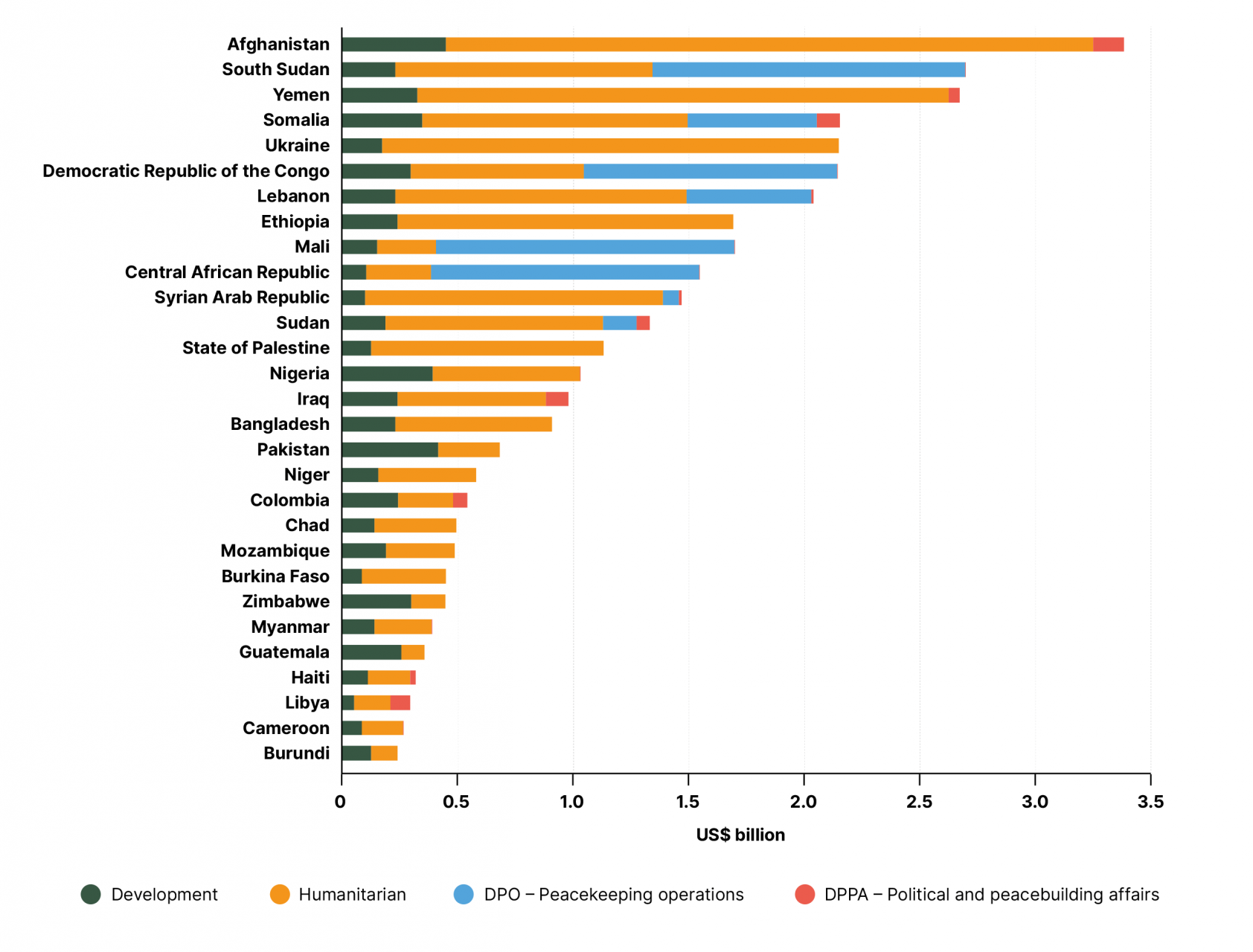This section focuses on UN expenditure in crisis-affected countries amid the context of the humanitarian-development–peace nexus. The nexus, which acknowledges the multi-dimensional nature of crises, aims to bridge humanitarian assistance and long-term development efforts while simultaneously addressing or preventing conflict.
Figure 31 displays the 29 crisis-affected countries that received UN expenditure beyond US$ 200 million in 2022. It also delineates the distribution between humanitarian assistance, development assistance, peacekeeping missions, and political and peacebuilding affairs. In 2022, UN expenditure across the 42 crisis-affected countries amounted to US$ 36 billion, 48% of which was directed to seven countries: Afghanistan, the Democratic Republic of Congo, Lebanon, Somalia, South Sudan, Ukraine and Yemen. Each of these countries received UN expenditure surpassing US$ 2 billion.
Breaking down total UN expenditure to the 29 crisis-affected countries featured in Figure 31, 62% of 2022 funding was directed to humanitarian activities, 18% to development assistance, and 20% to peacekeeping operations and political and peacebuilding affairs. Implementing projects or programmes in these countries is challenging not only due to security concerns, but because of limited capacity and access. Additionally, the challenges facing regional or cross-border programmes are heightened by the need for extensive coordination efforts and having to take account of political sensibilities among countries.
Several of the countries hosting ongoing UN peacekeeping operations in 2022 – such as the Democratic Republic of Congo (MONUSCO), Mali (MINUSMA), the Central African Republic (MINUSCA) and South Sudan (UNMISS) – have more than half their total UN expenditure allocated to peacekeeping operations and peacebuilding missions. There are also examples, as in Somalia, where there is a blend of expenditures along the humanitarian–development–peace nexus, with significant allocations made to political and peacebuilding affairs, as well as development assistance.
UN humanitarian, development, and peace- and security-related expenditure by crisis-affected country, 2022 (US$ billion)

Key insights in a flash
Report of the Secretary-General (A/79/72 - E/2024/12), Financial report of United Nations peacekeeping operations (A/78/5 (Vol.II)), Secretary-General proposed programme budget for special political missions (A/78/6 (Sec. 3)/Add.1).
By contrast, there are some crisis-affected countries where a large proportion of UN expenditure is directed towards development activities, as exemplified by Colombia (45%), Guatemala (72%), Pakistan (61%) and Zimbabwe (67%). Here, is it worth highlighting the increases in development expenditure seen in these countries over time. For instance, total UN development expenditure in Guatemala increased from US$ 67 million in 2015 to US$ 256 million in 2022. This is reflective of the UNDS’s attempts to scale up existing development activities – such as investments in basic health services, improving access to quality education and strengthening institutions – in order to reduce poverty and promote sustainable development.
As outlined in previous sections, conflict surge and acceleration has been a driving factor behind the escalating need for humanitarian support. Consequently, the majority of UN expenditure in crisis-affected countries has been allocated to emergency response and humanitarian assistance. Figure 32 depicts how the distribution of UN expenses in the 29 crisis-affected countries featured in Figure 31 has evolved over time. As can be seen, humanitarian assistance has grown steadily since 2010, while development, peace-keeping and peacebuilding operations have remained relatively constant over the same period.
Strategic UN allocations, alongside in-country coordination and emergency responses have been essential when it comes to addressing the complex challenges posed by multiple protracted conflicts. A confluence of crises, ranging from the Syrian civil war to conflicts in South Sudan, Yemen and Somalia, as well as irregular political transitions and conflicts – including those in Afghanistan and Ukraine – have inflicted substantial regional and global costs in terms of economic growth, food security and forced displacement.37 As such, these conflicts have played a significant role in the steady escalation of humanitarian needs and expenditure.
A considerable proportion of UN humanitarian expenditure has been allocated to expanding access to infrastructure and basic services for refugees, IDPs and host communities, as well as to safeguarding and protecting camps where they reside. By the end of 2022, the number of forcibly displaced individuals had surpassed 108.4 million people – two and a half times higher than a decade ago.38 Of this population, 71.1 million people are living in internal displacement. It is important to acknowledge that displacements are associated with conflict, violence and, increasingly, disasters, such as those triggered by the 2022 monsoon flooding in Pakistan, India and Bangladesh.39 Displacements have spillover effects that extend beyond forcibly displaced populations to encompass cross-border violence and regional instability.
UN humanitarian, development, and peace- and security-related expenditure in 29 crisis-affected countries, 2010-2022 (US$ billion)

Key insights in a flash
Report of the Secretary-General (A/79/72 - E/2024/12), Financial report of United Nations peacekeeping operations (A/78/5 (Vol.II)), Secretary-General proposed programme budget for special political missions (A/78/6 (Sec. 3)/Add.1). Historical data from various reports.
Endnotes
World Bank, ‘Qualitative Portfolio Meta-analysis —Input for the Mid-Term Review of the World Bank Group Strategy for Fragility, Conflict, and Violence (2020–25)’, 2023, p. 45, https://documents1.world-bank.org/curated/en/099102523150028132/pdf/BOS….
UN Department of Economic and Social Affairs (DESA), ‘Goal 16’, https://sdgs.un.org/goals/goal16. See also (https://www.unhcr.org/refugee-statistics/.
Internal Displacement Monitoring Centre (IDMC), ‘2023 Global Report on Internal Displacement (GRID)’, 2023, p. 7-12, https://www.internal-displacement.org/publications/2023-global-report-o…